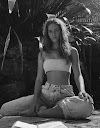"You, wild foam.
You, good-for-nothing snail, you who don't love me."
- excerpt from "Still?" by Wassily Kandinsky, translated by Elizabeth R. Napier from Sounds, New Haven, Yale University Press: 1981.
What do we have here in Gustave de Smet's painting The Inn? Superficially, an ordinary scene of evening conviviality: a quartet of men playing cards, a barmaid standing by with a round of drinks, and two men playing darts. But the spaces between these characters have gone missing, leading to an overall sense of claustrophobia, intensified by the proportions of the canvas, imparting a sinister potential to the dart-throwers. Surely they aim too close for the the comfort of their fellows, a suggestion of misgivings about where modernity was taking the world. By the time De Smet painted The Inn in 1924, he had begun incorporating elements of Cubism into the faces of his characters, their stylized flatness mask-like. Still we search them for hints of emotion. The brilliant colors used by the Fauves ("wild beasts" so-called, by their critics) took on darker hues in the Expressionist paintings of the 1920s.
Like three horsemen of the Apocalypse, Darwin, Marx, and Nietzsche trampled the values that had been pillars underpinning European civilization to a heap of rubble at the turn of the last century. Modern times always seems unprecedented to those living through them. For some though, the disarray offered a springboard to the new. Expressionism in art, in music, and in literature, was heightened sensitivity to the speed and uncertainty of life. Are we really moving forward or just running amok, artists wondered.
Paradise is yours for a dime." So wrote Ivan Goll (1891-1950), a bilingual French-German poet best remembered today for the contretemps about his work being plagiarized by his close friend Paul Celan. Goll was also the librettist for Kurt Weill's 1927 opera Royal Palace. Like other, better known expressionist poets as Gottfried Benn, Else Lasker-Schuler, and Georg Trakl, Goll's poems were highly visual in their effects. Even the painter Wassily Kandinksy wrote poetry ("Still?"). If the Americans had their "Jazz Age" fizz and the French had their "Annees Folles" (Crazy Years), there were some who thought otherwise: the Expressionists were wont to look on the dark side
Gustave de Smet (1877-1943) was a Belgian painter who was exposed to art-making in the studio of his father Jules, a set director. During World War I, de Smet fled to Belgium, among the first of many moves in his peripatetic career. Social scenes, such as fairs and playgrounds, were his favorite theme.
Image:
Gustave de Smet - De Herberg (The Inn) 1924, De Bode Collection, Ghent, Belgium.





0 Yorumlar